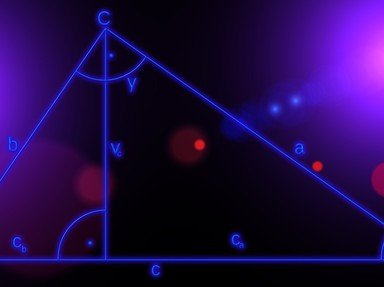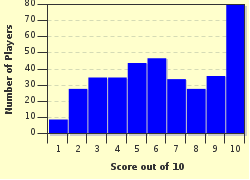Quiz Answer Key and Fun Facts
1. A common theme throughout this quiz will be that even if you have trouble visualizing 4-dimensional objects, it's possible to understand their properties by looking at how objects in much easier to visualize dimensions behave.
For example, we know that a 1-dimensional line segment has two endpoints. If we move up by a dimension we get to a square, which has four corners. Moving up a dimension further, we reach a cube, which has eight corners, twice as many as the square. If we were to move up one more dimension, how many corners does a 4-dimensional box (or "hypercube") have?
2. A 1-dimensional line segment can be thought of as joining together two endpoints. Similarly, a 2-dimensional square joins together four 1-dimensional sides. A 3-dimensional cube has six 2-dimensional square faces (think of a six sided die, for example).
Given all this, how many 3-dimensional cubes should you expect make up the sides ("faces") of a hypercube?
3. In addition to counting corners and sides, we can also count edges, that is to say line segments connecting two of the corners together. A square has four edges (the four sides), while a cube has twelve: four on the top square, four on the bottom square, and four vertical edges connecting a vertex on top to one on the bottom. How many does a 4-dimensional hypercube have?
4. Suppose I were to take a 4-dimensional hypercube and double the length of every side. What would that do to the (4-dimensional) volume?
5. If you take a square of side length 1, two opposite corners are located sqrt(2) units from each other. What is the corresponding distance between two opposite corners of a 4-dimensional hypercube? As usual, you may want to start by figuring out what happens in 3 dimensions (or 1 dimension!)
6. We've seen that a hypercube fits naturally in the progression: line segment, square, cube, hypercube. In the same way, we can ask how to extend the progression: line segment, triangle, tetrahedron (triangular pyramid)... to the fourth dimension. Such an extension is known as a 4-dimensional "simplex".
Just like a triangle consists of a single point in a second dimension connected to a line segment, and a tetrahedron consists of a single point in a third dimension connected to a triangle, a 4-dimensional simplex consists of a single point in a new dimension connected to a tetrahedron. How many vertices (or corners) would such a simplex have?
7. Just like a 4-dimensional hypercube has faces (sides) that are 3-dimensional cubes, we can think of a 4-dimensional simplex as having faces that are 3-dimensional tetrahedra. How many of these faces are there?
If you're not sure, remember that one good idea is to start by visualizing things in smaller dimensions and looking for patterns!
8. In 1 dimension, a line segment consists of a single edge. In 2 dimensions, a triangle has three sides. In 3 dimensions, a tetrahedron has six edges (three on the bottom face, and another three connecting to the new vertex). Going up one further dimension, how many edges does a 4-dimensional simplex have?
9. Suppose I were to take a 4-dimensional simplex and double the length of every side. What would that do to the (4-dimensional) volume?
10. The idea that you can understand higher dimensions by looking at lower ones and proceeding by analogy is far from new. In what 1884 novel did Edwin A. Abbott describe the adventures of A. Square as he tried to cope with the appearance of a 3-dimensional sphere in his 2-dimensional world?
Source: Author
kevinatilusa
This quiz was reviewed by FunTrivia editor
rossian before going online.
Any errors found in FunTrivia content are routinely corrected through our feedback system.

